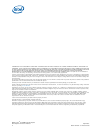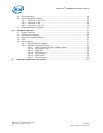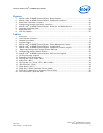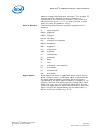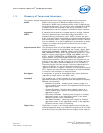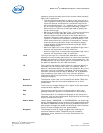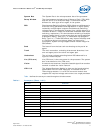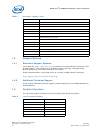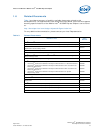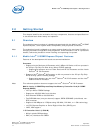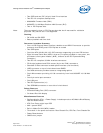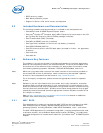
Mobile Intel
®
915GME Express Chipset
April 2007 Development Kit User’s Manual
Order Number: 317230-001US 9
About This Manual—Mobile Intel
®
915GME Express Chipset
1.3 Glossary of Terms and Acronyms
This section defines conventions and terminology used throughout this document.
ADD2 ADD2 is an acronym for Advanced Digital Display, 2nd
Generation. ADD2 video interfaces come in two configurations:
Normal and Reversed. The normal is often referred to as ADD2
or ADD2-N and the reversed is referred to as ADD2-R. The
915GM platform can only support the ADD2-R video interface.
Aggressor A network that transmits a coupled signal to another network.
AGTL+ The front-side bus uses a bus technology called AGTL+, or
Assisted Gunning Transceiver Logic. AGTL+ buffers are open-
drain, and require pull-up resistors to provide the high logic level
and termination. AGTL+ output buffers differ from GTL+ buffers
with the addition of an active pMOS pull-up transistor to assist
the pull-up resistors during the first clock of a low-to-high
voltage transition.
Asynchronous GTL+ The processor does not utilize CMOS voltage levels on any
signals that connect to the processor. As a result, legacy input
signals such as A20M#, IGNNE#, INIT#, LINT0/INTR, LINT1/
NMI, PWRGOOD, SMI#, SLP#, and STPCLK# utilize GTL+ input
buffers. Legacy output signals (FERR# and IERR#) and non-
AGTL+ signals (THERMTRIP# and PROCHOT#) also utilize GTL+
output buffers. All of these signals follow the same DC
requirements as AGTL+ signals, however the outputs are not
actively driven high (during a logical 0 to 1 transition) by the
processor (the major difference between GTL+ and AGTL+).
These signals do not have setup or hold time specifications in
relation to BCLK[1:0], and are therefore referred to as
“Asynchronous GTL+ Signals”. However, all of the Asynchronous
GTL+ signals are required to be asserted for at least two BCLKs
in order for the processor to recognize them.
Bus Agent A component or group of components that, when combined,
represent a single load on the AGTL+ bus.
Crosstalk The reception on a victim network of a signal imposed by
aggressor network(s) through inductive and capacitive coupling
between the networks.
• Backward Crosstalk - Coupling that creates a signal in a
victim network that travels in the opposite direction as the
aggressor’s signal.
• Forward Crosstalk - Coupling that creates a signal in a
victim network that travels in the same direction as the
aggressor’s signal.
• Even Mode Crosstalk - Coupling from a signal or multiple
aggressors when all the aggressors switch in the same
direction that the victim is switching.
• Odd Mode Crosstalk - Coupling from a signal or multiple
aggressors when all the aggressors switch in the opposite
direction that the victim is switching.
Flight Time Flight time is a term in the timing equation that includes the
signal propagation delay, any effects the system has on the TCO
of the driver, plus any adjustments to the signal at the receiver




